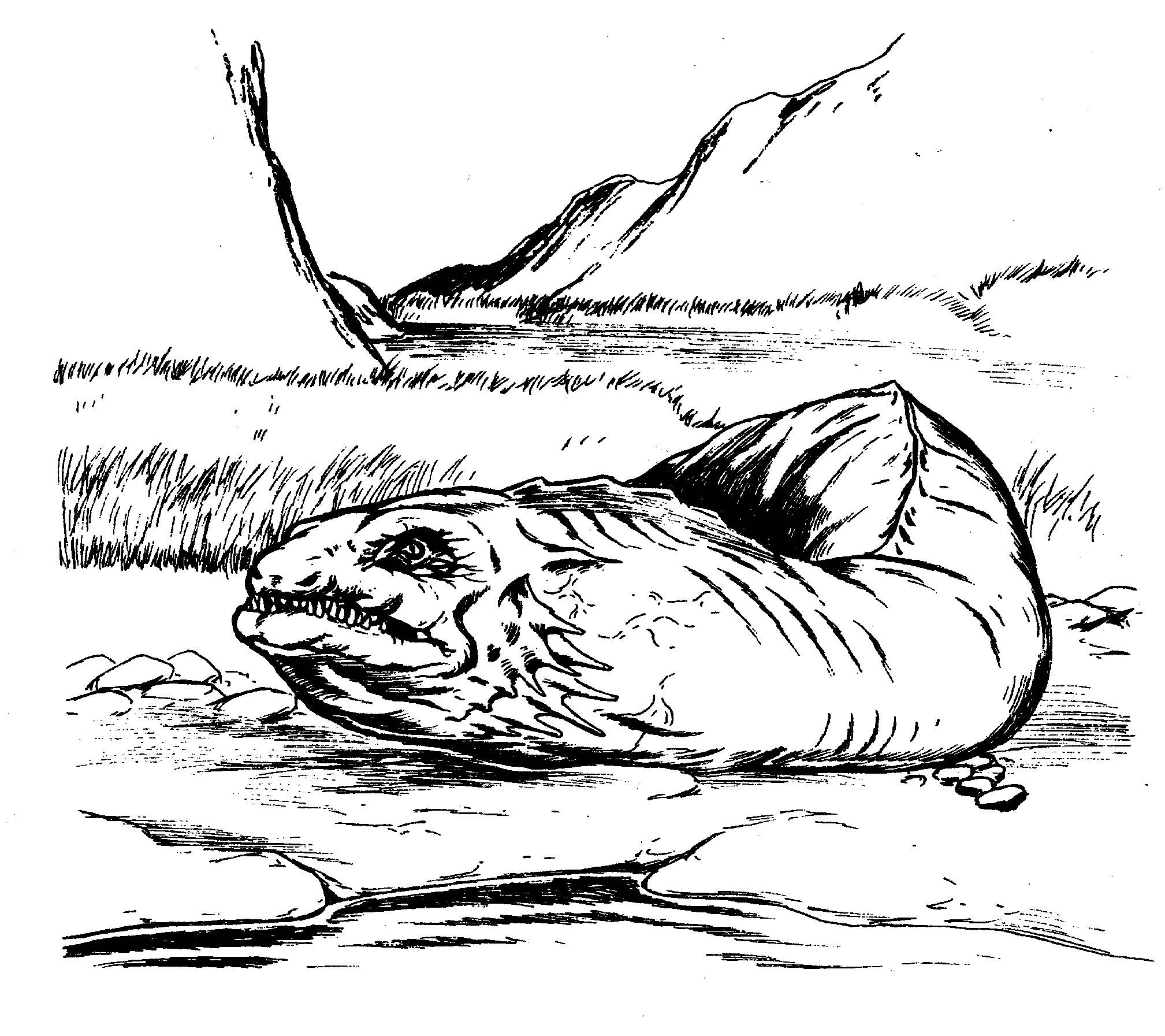
| Climate/Terrain: | Subarctic/Lakes(guivre); Temperate and Subtropical/Swamp (knucker) |
|---|---|
| Frequency: | Rare |
| Organization: | Solitary |
| Activity Cycle: | Any |
| Diet: | Carnivore |
| Intelligence: | Low (5-7) |
| Treasure: | G |
| Alignment: | Neutral evil |
| No. Appearing: | 1 (10% of 2) |
| Armor Class: | 4 |
| Movement: | 9, Sw 15 |
| Hit Dice: | 8 |
| THAC0: | 13 |
| No. of Attacks: | 1 or 2 |
| Damage/Attack: | 4-16 or 4-16/2-16 |
| Special Attacks: | Breath weapon, constriction, surprise |
| Special Defenses: | Half damage from fire-based (guivre) or frost-based (knucker) attacks |
| Magic Resistance: | Nil |
| Size: | G (30’-40’ long) |
| Morale: | Steady (12) |
| XP Value: | 5,000 |
Swamp wyrms are huge legless reptiles that are distantly related to dragons; they also appear to be related to constrictor snakes. Their bodies are serpentine, but their heads are quite draconic. Swamp wyrms come in two distinct though similar species: the knucker and the guivre (giv'- ray), names given them before it was realized that they were so closely related. The olive-hued knucker prefers warm climates, while the pale-green guivre loves cold ones. They can breathe water or air with equal ease.
Combat: The swamp wyrm's favoredhunting method is to lie barely submergedin murky water (it can see perfectly through it), then grab anything that comes down to drink. This tactic gives it a +2 bonus to surprise. A swamp wyrm fights using a bite-constriction combination. If it can successfully bite an opponent, it then attempts to wrap its body around the foe (requiring another attack roll). A successful hit means the victim has been caught in the swamp wyrm's coils and can be crushed starting on the following round; the victim can also be bitten with a +4 to the swamp wyrm's attack roll, the victim gaining no dexterity or shield bonuses,once per round thereafter. Each wyrm also has a breath weapon: a 30' cone, 5'wide at the base and 15' at its terminus. The breath weapon does 4-40 hp damage (half with a saving throw vs. breath weapons). The guivre (surprisingly) breathes fire, and the knucker breathes frost. In general, the breath weapon will be saved for emergencies or obviously dangerous opponents, as it can be used only three times a day. A swamp wyrm will also take only half damage from attack forms similar to its breath weapon (i.e., fire and heat for the guivre, and frost and cold for the knucker).
Habitat/Society: Swamp wyrms make their homes in remote wilderness areas, in small, still lakes called either knucker holes or guivre pools, depending on the occupant. The water temperature is strongly affected by a magical secretion from the swamp wyrms' scales. Guivre pools are always steaming hot, melting snow and ice around them like hot springs, while knucker holes are chill, fogshrouded, and sometimes iced over, killing all vegetation around them. Stagnant waters from these lakes are poisonous to all except swamp wyrms and other reptiles, thanks to the secretion; those drinking the water must save vs. poison or suffer 1-4 hp damage per round for 1-6 rounds.
Like dragons, swamp wyrms prefer to live alone, coming together only in the spring for mating though they rarely if ever fight with one another. Male and female swamp wyrms of either species collect treasure hoards, which they display to all other visiting wyrms. The wyrms with the most treasure in their hoards have first pick of the available members of the opposite sex for purposes of mating, leading many sages to suppose that drag ons gather treasure for similar reasons (although this isn't particularly true). This seems to be the only reason they bother to collect treasure, as they never use it to bargain, either to gain allies or to save their own lives. Swamp wyrms give birth to 1-4 young three months after mating.
Swamp wyrms speak only a very crude language (dubbed Wyrmic), reserving their brain power for discovering clever ways to capture prey. They will eagerly fight all other large creatures besides themselves, including dragons, in order to gain more treasure.
Ecology: Swamp wyrms are fierce carnivores, living on any creatures that come too near their pools. They often slither into nearby bodies of water, even oceans, to hunt food (most animals soon learn to avoid the poisonous lakes these creatures inhabit). A few prefer to live near weakly defended civilized areas, or at least ones near major rivers that lead to these places, to assure plenty of human or humanoid prey and the domestic animals associated with them. Unlike dragons, swamp wyrms eat frequently, destroying all wildlife, and they are sometimes considered more of a problem than certain dragons are.
Swamp wyrms rest at the top of their local food chain, but they actively destroy the local ecology around their lakes and ravage the wildlife nearby. Adventurers and large monsters are their only true enemies, but most swamp wyrms live where neither foe is in great supply. Numerous uses have been rumored for their body parts, particularly the many glands under their scales that give off the wateraffecting secretion.
